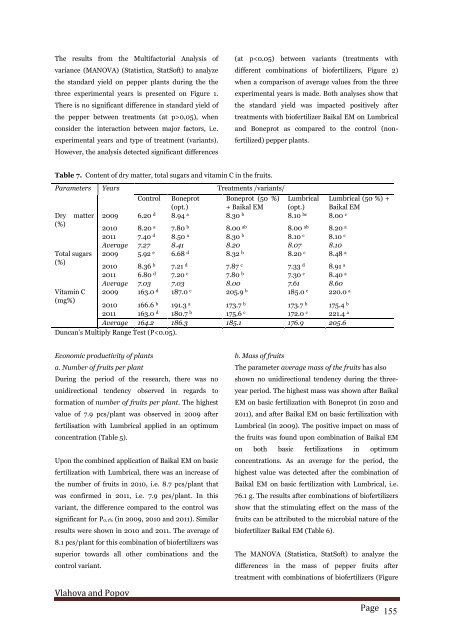Improvement of productivity and quality of pepper (Capsicum annuum L.) resulting from biofertilizer applications under organic farming
Abstract Organic agriculture is a holistic production management system which promotes and enhances agro-ecosystem health optimizing biological cycles and soil biological activity. Such optimization often relies on so called biofertilizers which could improve the soil nutrient management. With aim to study the effect of such group of biofertilizers on productivity and quality of economically importanbt crop such as pepper (Capsicum annuum L.) variety Kurtovska Kapiya 1619, an experiment was carried out in 2009-2011 on the experimental fields of the Agroecological Centre at the Agricultural University-Plovdiv (Bulgaria). Solid biofertilizers, i.e. Boneprot and Lumbrical, and a liquid biofertilizer Baikal EM were tested. The content of the total digestible N, K2O and humus at the end of the vegetation showed the highest values after application of Boneprot in an optimum concentration. The highest standard yield was measured after Baikal EM on basic fertilization with Lumbrical, i.e. 15980 kg.ha-1 in 2009. The result was confirmed in 2011, i.e. 16540 kg.ha-1. The increase in comparison with the control variants was by 61.8% and 43.8 % respectively. Upon the combined application of Baikal EM on basic fertilization with Lumbrical, there was an increase of the number of fruits in 2010, i.e. 8.7 pcs/plant that was confirmed in 2011, i.e. 7.9 pcs/plant. The highest mass of the fruits was shown after Baikal EM on basic fertilization with Boneprot (in 2010 and 2011). The maximum value of the pericarp thickness was detected for the fruits of the variant treated with Baikal EM on basic fertilization with Boneprot. The combined application of biofertilizers showed a higher stimulative impact than the single application of biofertilizers. The higher total sugars and Vitamin C content in the pepper fruits after treatment with Baikal EM on basic fertilization with Lumbrical, determined this combination as favourable.
Abstract
Organic agriculture is a holistic production management system which promotes and enhances agro-ecosystem health optimizing biological cycles and soil biological activity. Such optimization often relies on so called biofertilizers which could improve the soil nutrient management. With aim to study the effect of such group of biofertilizers on productivity and quality of economically importanbt crop such as pepper (Capsicum annuum L.) variety Kurtovska Kapiya 1619, an experiment was carried out in 2009-2011 on the experimental fields of the Agroecological Centre at the Agricultural University-Plovdiv (Bulgaria). Solid biofertilizers, i.e. Boneprot and Lumbrical, and a liquid biofertilizer Baikal EM were tested. The content of the total digestible N, K2O and humus at the end of the vegetation showed the highest values after application of Boneprot in an optimum concentration. The highest standard yield was measured after Baikal EM on basic fertilization with Lumbrical, i.e. 15980 kg.ha-1 in 2009. The result was confirmed in 2011, i.e. 16540 kg.ha-1. The increase in comparison with the control variants was by 61.8% and 43.8 % respectively. Upon the combined application of Baikal EM on basic fertilization with Lumbrical, there was an increase of the number of fruits in 2010, i.e. 8.7 pcs/plant that was confirmed in
2011, i.e. 7.9 pcs/plant. The highest mass of the fruits was shown after Baikal EM on basic fertilization with Boneprot (in 2010 and 2011). The maximum value of the pericarp thickness was detected for the fruits of the variant treated with Baikal EM on basic fertilization with Boneprot. The combined application of biofertilizers showed a higher stimulative impact than the single application of biofertilizers. The higher total sugars and Vitamin C content in the pepper fruits after treatment with Baikal EM on basic fertilization with Lumbrical, determined this combination as favourable.
Create successful ePaper yourself
Turn your PDF publications into a flip-book with our unique Google optimized e-Paper software.
The results <strong>from</strong> the Multifactorial Analysis <strong>of</strong><br />
variance (MАNOVA) (Statistica, StatS<strong>of</strong>t) to analyze<br />
the st<strong>and</strong>ard yield on <strong>pepper</strong> plants during the the<br />
three experimental years is presented on Figure 1.<br />
There is no significant difference in st<strong>and</strong>ard yield <strong>of</strong><br />
the <strong>pepper</strong> between treatments (at p>0,05), when<br />
consider the interaction between major factors, i.e.<br />
experimental years <strong>and</strong> type <strong>of</strong> treatment (variants).<br />
However, the analysis detected significant differences<br />
(at p





![Review on: impact of seed rates and method of sowing on yield and yield related traits of Teff [Eragrostis teff (Zucc.) Trotter] | IJAAR @yumpu](https://documents.yumpu.com/000/066/025/853/c0a2f1eefa2ed71422e741fbc2b37a5fd6200cb1/6b7767675149533469736965546e4c6a4e57325054773d3d/4f6e6531383245617a537a49397878747846574858513d3d.jpg?AWSAccessKeyId=AKIAICNEWSPSEKTJ5M3Q&Expires=1714122000&Signature=KRQi2WkdrZcIEo7i%2F6CJEuH1eUw%3D)












